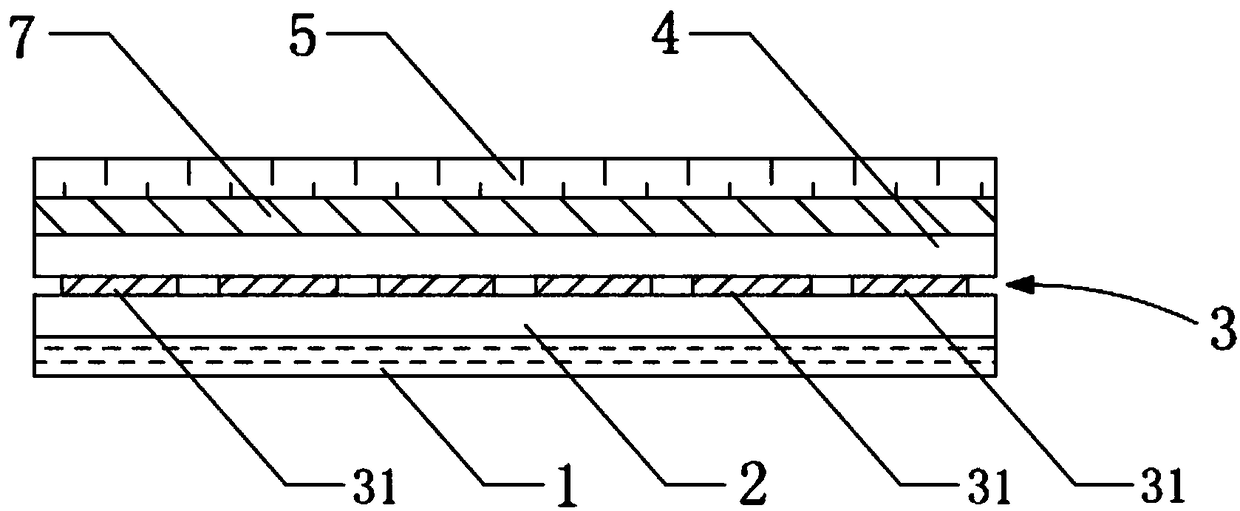Photovoltaic module resisting potential induced degradation
A potential-induced attenuation, photovoltaic module technology, applied in the field of solar photovoltaic, can solve the problems of power station loss, photovoltaic module power loss, affecting the reliability and stability of photovoltaic modules, etc., to reduce reflection, improve absorption rate, and improve photoelectric conversion efficiency. Effect
- Summary
- Abstract
- Description
- Claims
- Application Information
AI Technical Summary
Problems solved by technology
Method used
Image
Examples
Embodiment 1
[0021] refer to figure 1 and figure 2 As shown, the present embodiment provides a photovoltaic module that resists potential-induced attenuation, including a backplane 1, a first EVA layer 2, a solar cell layer 3, a second EVA layer 4, and a glass 5 arranged in sequence. The battery sheet layer 3 includes a plurality of solar battery sheets 31 arranged in an array, wherein a silicon nitride film layer 6 is arranged between the second EVA layer 4 and the glass 5, and the silicon nitride film layer 6 It is used to prevent metal ions in the glass 5 from migrating toward the solar cells 31 .
[0022] The anti-potential induced attenuation photovoltaic module blocks the free metal ions in the glass 5 from moving towards the solar cells by setting a silicon nitride film layer 6 between the second EVA layer 4 and the glass 5 31 migration, which effectively weakens the potential-induced attenuation phenomenon of the photovoltaic module and prevents the photoelectric conversion effi...
Embodiment 2
[0035] refer to image 3 As shown, the present invention also provides another anti-potential-induced degradation photovoltaic module, including a back plate 1, a first EVA layer 2, a solar cell layer 3, a second EVA layer 4 and a glass 5 arranged in sequence, the The solar battery sheet layer 3 includes a plurality of solar battery sheets 31 arranged in an array, wherein a silicon dioxide thin film layer 7 is arranged between the second EVA layer 4 and the glass 5, and the silicon dioxide thin film layer 7 is used to prevent metal ions in the glass 5 from migrating toward the solar cells 31 .
[0036] Similarly, the silicon dioxide thin film layer 7 can not only block the free metal ions such as sodium ions and calcium ions in the glass 5 from migrating to the solar cell layer 3, but also the silicon dioxide thin film Layer 7 can also be used as an anti-reflection film to reduce the reflection of the photovoltaic module on sunlight, increase the absorption rate of incident lig...
PUM
| Property | Measurement | Unit |
|---|---|---|
| Thickness | aaaaa | aaaaa |
| Thickness | aaaaa | aaaaa |
| Thickness | aaaaa | aaaaa |
Abstract
Description
Claims
Application Information
 Login to View More
Login to View More - R&D
- Intellectual Property
- Life Sciences
- Materials
- Tech Scout
- Unparalleled Data Quality
- Higher Quality Content
- 60% Fewer Hallucinations
Browse by: Latest US Patents, China's latest patents, Technical Efficacy Thesaurus, Application Domain, Technology Topic, Popular Technical Reports.
© 2025 PatSnap. All rights reserved.Legal|Privacy policy|Modern Slavery Act Transparency Statement|Sitemap|About US| Contact US: help@patsnap.com



